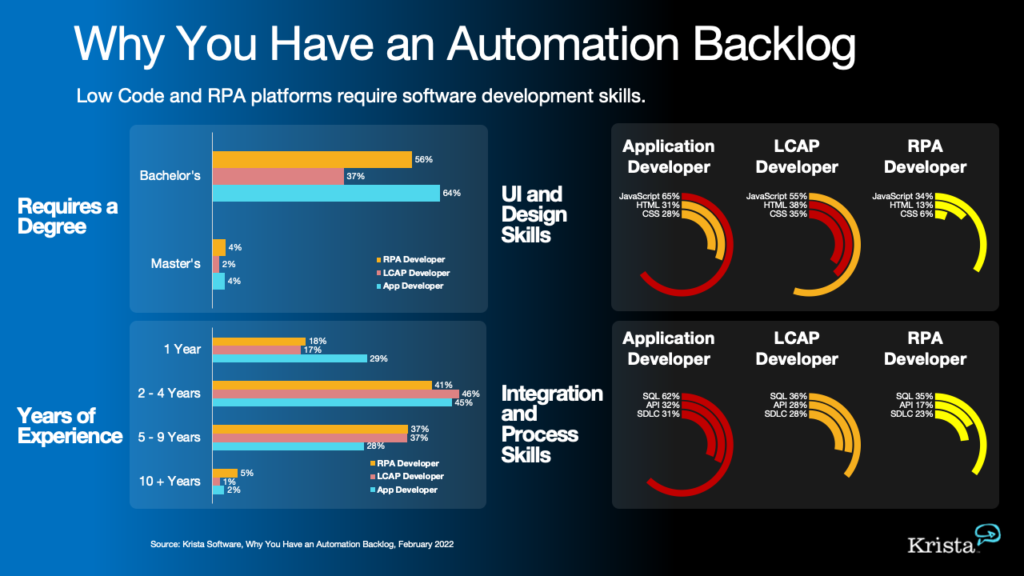RPA and low code application platforms jobs require just as many software development skills as custom application development.
Why it matters: Business leaders will continue to become frustrated with slow delivery and innovation cycle times.
The big picture: Highly technical platforms combined with scarce development resources will continue to challenge digital transformation projects.

Earlier I wrote about how Low Code Application Platforms Require Software Development Skills. I scraped 400 job postings from LinkedIn and compared the required skills for application developer jobs and those calling for low code skills. If the job posting mentioned Appian, OutSystems, Microsoft Power Automate, Mendix, ServiceNow, Salesforce, or Oracle, I grouped it as “LCAP Developer.” If an application developer job posting did not mention a specific platform, I placed it in the “Application Developer” group. I found the two groups very similar and found the data suggests that low code platforms require the same software development skills as enterprise software.
Most readers found the data to be quite surprising. Many thought the low code jobs would require fewer skills than software development. I hypothesized the same before I summarized the data and found the two datasets almost precisely overlapped. One reader suggested taking it one more step and perform the same analysis for RPA developers. Even though low code tools and RPA tools aren’t the same things, companies do use both to help with digital transformation projects. I obliged the reader and added RPA data to my previous chart.
Most of the job postings (90%) state a minimum number of years RPA applicants must have. Overall, the percentage of jobs requiring one year, 2-4 years, and more than ten years are similar. However, more of the RPA jobs require more years of experience. Three jobs in our random dataset required 15 years of RPA experience! [Link to data]
Interestingly, more RPA jobs require degrees than low code and application development jobs. Fifty-six percent (56%) of the RPA job postings require a Bachelor’s degree and four percent (4%) require a Master’s degree.
I compared all job postings in the same manner as the low code postings. I looked at UI and design skill requirements and integration and process requirements.
Overall, fewer RPA job postings state HTML, CSS, and JavaScript skill requirements. Thirteen percent (13%) of RPA jobs in our sample require HTML, only six percent (6%) require CSS, and thirty-four percent (34%) require JavaScript. This makes sense since the technologies operate differently with one building apps and the other automating user processes across apps, screens, and APIs.
Many of the RPA jobs require process and integration skills. Compared to the Application Developer jobs and LCAP Developer jobs, only seventeen percent (17%) of the RPA jobs require API experience. However, the most critical finding is that Agile and software development lifecycle requirements are relatively the same. Twenty-three percent (23%) of the RPA jobs require these skills. Process skills are necessary because even though these automation tools offer efficiency, they still need to be scoped, developed, tested, and deployed. This is why automation backlogs are so large. There are a lot of steps that need to take place by relatively few people.
The reasons we are providing this data are two-fold. One is to show that no matter which low code or RPA platform you choose, you will need skilled resources—and skilled resources are challenging to obtain. Secondly, there is a better alternative.
Krista is the technology that understands people. Krista is a nothing-like-code intelligent automation platform that provides an easy way to build complex automations across multiple people, teams, apps, and AI. Building intelligent automations in Krista doesn’t require the technical skills mentioned above.
Automate Complete Business Processes: Krista provides a nothing-like code interface to build automations across multiple people and apps to drive business outcomes and not just mundane tasks.
Takes Minutes, not Months: Process owners can edit automations in minutes, not months. Krista provides an easy interface that personifies systems and apps, so you don’t need technical skills to innovate.
Reduces Complexity: Krista reduces complexity for functions and processes that your people are running today. Krista can consolidate multiple apps into a single conversational interface to reduce the number of apps and screens your people are using today. With Krista, your people can move on to more meaningful work.
Integrate AI: Automating processes with Krista provides a path to operationalizing machine learning into your company. You can “Ask Krista” for decision support or use her to integrate your models into a complete workflow to make your model more valuable.
See how several LLMs fared in our test and steps to run your own tests for each of your use cases.

© Krista Software | Privacy Policy | Terms of Service
| Cookie | Duration | Description |
|---|---|---|
| cookielawinfo-checkbox-analytics | 11 months | This cookie is set by GDPR Cookie Consent plugin. The cookie is used to store the user consent for the cookies in the category "Analytics". |
| cookielawinfo-checkbox-functional | 11 months | The cookie is set by GDPR cookie consent to record the user consent for the cookies in the category "Functional". |
| cookielawinfo-checkbox-necessary | 11 months | This cookie is set by GDPR Cookie Consent plugin. The cookies is used to store the user consent for the cookies in the category "Necessary". |
| cookielawinfo-checkbox-others | 11 months | This cookie is set by GDPR Cookie Consent plugin. The cookie is used to store the user consent for the cookies in the category "Other. |
| cookielawinfo-checkbox-performance | 11 months | This cookie is set by GDPR Cookie Consent plugin. The cookie is used to store the user consent for the cookies in the category "Performance". |
| viewed_cookie_policy | 11 months | The cookie is set by the GDPR Cookie Consent plugin and is used to store whether or not user has consented to the use of cookies. It does not store any personal data. |
<script charset=”utf-8″ type=”text/javascript” src=”//js.hsforms.net/forms/embed/v2.js”></script>
<script>
hbspt.forms.create({
region: “na1”,
portalId: “20318565”,
formId: “2f371401-4e02-463f-b974-31e781d29fb0”
});
</script>

